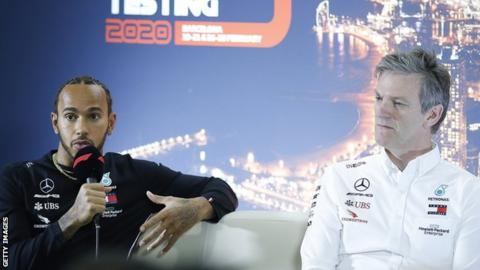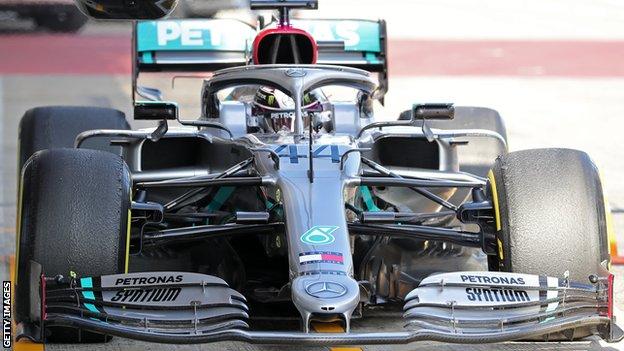
Mercedes believe a trick steering innovation which could give them an advantage in 2020 is within the rules.
Technical director James Allison said it “introduces an extra dimension for steering which we hope will be useful”.
He said governing body the FIA was aware of it. “The rules are clear about what’s permitted on steering systems. We’re pretty confident that it matches those requirements,” he said.
He declined to elaborate further on the purposes of the system.
- F1 testing live text schedule
- Too skint to win?
- F1’s new cars gallery
- Formula 1 2020: your questions answered
The so-called ‘dual-axis steering’ system allows the driver to alter the ‘toe-in’ of the front wheels – or their angle to the longitudinal axis of the car – while driving.
World champion Lewis Hamilton said: “We’re trying to get on top of it, understand it, but safety-wise no problem today and the FIA are OK with the project.
“For me it’s really encouraging to see that my team is continuing to innovate and stay ahead of the game, and I think that’s down to the great minds in the team and so hopefully that’ll work to our benefit.”
The system came to light from on-board camera footage on the second day of the first pre-season test at Spain’s Circuit de Barcelona-Catalunya.

Hamilton could be seen pulling the steering wheel towards him at the start of straights, which appeared to change the toe-in of the front wheels by moving their forward edges towards the centreline of the car.
Then, before the next corner, he would push the steering wheel away from him again, which changed the toe-in back so the leading edge of the front wheels was angled further away from the car.
The exact purposes of the system are not clear but all F1 cars run with a degree of ‘toe-out’ on the front wheels because it aids turn-in to corners.
However, as this means the wheels are not perfectly parallel to the car, it creates a degree of ‘tyre scrub’ on the straights, where the tyre is being dragged slightly at an angle.
This can cause problems with tyre temperature, which is a crucial area of F1 car performance.
Allison refused to explain how the system worked, saying: “I hope you’ll forgive me for not expanding further. I’m pleased we got it on the car, it seems to be useful, and we’ll see over the coming days how it benefits us.”
F1 teams are always searching for design innovations within the boundaries of the rules that can give them a decisive advantage over their rivals.
If the system makes the Mercedes quicker – and they would not have put it on the car if not – it could take other teams weeks or even months before they can negate that advantage with their own versions of the design.
Hamilton is this year aiming to win a seventh world title, which would equal the all-time record of Michael Schumacher, while Mercedes are bidding to expand their record of six consecutive driver and constructors’ championship doubles into a seventh year.
